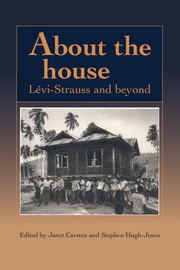Book contents
- Frontmatter
- Contents
- List of illustrations
- List of contributors
- 1 Introduction
- 2 Houses and hierarchies in island Southeast Asia
- 3 The resurrection of the house amongst the Zafimaniry of Madagascar
- 4 The hearth-group, the conjugal couple and the symbolism of the rice meal among the Kelabit of Sarawak
- 5 Houses in Langkawi: stable structures or mobile homes?
- 6 Having your house and eating it: houses and siblings in Ara, South Sulawesi
- 7 The Lio House: building, category, idea, value
- 8 Houses and hierarchy: the view from a South Moluccan society
- 9 Houses, places and people: community and continuity in Guiana
- 10 The houses of the Mẽbengokre (Kayapó) of Central Brazil – a new door to their social organization
- 11 Inside-out and back-to-front: the androgynous house in Northwest Amazonia
- Notes
- Bibliography
- Index
6 - Having your house and eating it: houses and siblings in Ara, South Sulawesi
Published online by Cambridge University Press: 05 June 2012
- Frontmatter
- Contents
- List of illustrations
- List of contributors
- 1 Introduction
- 2 Houses and hierarchies in island Southeast Asia
- 3 The resurrection of the house amongst the Zafimaniry of Madagascar
- 4 The hearth-group, the conjugal couple and the symbolism of the rice meal among the Kelabit of Sarawak
- 5 Houses in Langkawi: stable structures or mobile homes?
- 6 Having your house and eating it: houses and siblings in Ara, South Sulawesi
- 7 The Lio House: building, category, idea, value
- 8 Houses and hierarchy: the view from a South Moluccan society
- 9 Houses, places and people: community and continuity in Guiana
- 10 The houses of the Mẽbengokre (Kayapó) of Central Brazil – a new door to their social organization
- 11 Inside-out and back-to-front: the androgynous house in Northwest Amazonia
- Notes
- Bibliography
- Index
Summary
Lévi-strauss sees the ‘house’ as a solution to the problems of societies where ‘political and economic interests’ have not yet ‘overstepped the old ties of blood’, in other words where class divisions must still be represented in a pre-class ideology of shared descent and alliance. He sees the house concept as having special relevance in the context of Indonesia. However, in Indonesia, we find houses playing a key symbolic role in a whole range of social forms, from self-sufficient, egalitarian tribes, to maritime empires, to oriental despotisms. Societies at all these levels make use of the house as a symbolic device to represent social groups. I will argue here that Lévi-Strauss's concept of the ‘house’ cannot be applied in a straightforward way to the Indonesian societies characterized by Errington as ‘centrist’ (Errington 1989). This is because an idiom of siblingship, linked to an idiom of shared place, is far more important in organizing social life than are alliance and descent, the idioms to which Lévi-Strauss gives prominence.
In another sense, however, Lévi-Strauss's concept does have great relevance for some societies in Indonesia in which competition for wealth and power among the upper strata is intense but has not led to stable class divisions. These societies do make use of the house in a manner highly reminiscent of Lévi-Strauss's European, Japanese and Kwakiutl examples.
- Type
- Chapter
- Information
- About the HouseLévi-Strauss and Beyond, pp. 129 - 148Publisher: Cambridge University PressPrint publication year: 1995
- 16
- Cited by



